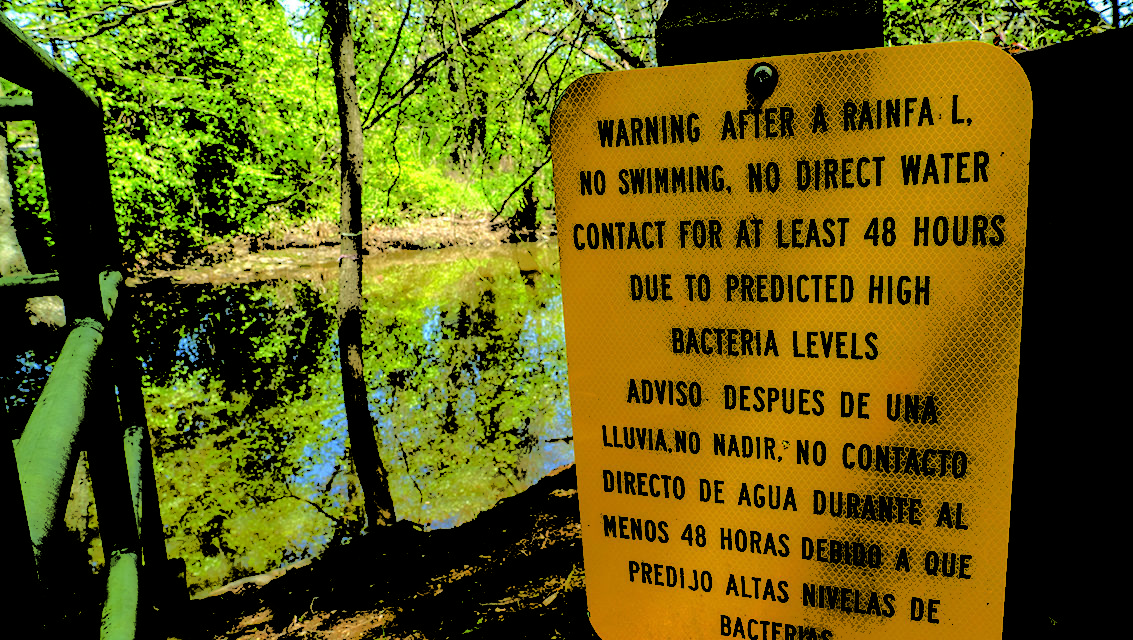By Whitney Pipkin, Bay Journal News Service
There are plenty of reasons to stay out of some Chesapeake Bay waters, particularly after a heavy rain. When stormwater hits local waterways, it may be carrying bacteria, toxins, animal waste and even raw sewage. Can it carry the coronavirus too?
Some researchers are tracking the virus’ presence in sewage as an indication of how many people might be infected in a given area. They also are hustling to answer a secondary question: If the virus can be detected in sewage, could it also be in waterways that are tainted with sewage after it rains?
The short answer is yes — but probably not in a form that could infect additional people. While the virus that causes COVID-19 can be detected in untreated wastewater, the U.S. Centers for Disease Control and Prevention say “there is no evidence to date” that a person exposed to it in this form can contract the disease.
There are, however, still plenty of reasons to be concerned about swimming or recreating in water that has recently been polluted by sewage or stormwater runoff. As swimming season begins, experts who study waterborne diseases say that catching the coronavirus from water contact is probably among the least of those concerns.
“Sewage was already dangerous. That’s why we have these standards about recreational waters,” said Mark Mattson, president of the nonprofit Swim Drink Fish and Waterkeeper for Canada’s Lake Ontario.
Mattson said he’s more concerned about people being able to prevent virus transmission by maintaining a social distance on busy beaches than he is about coronavirus spreading through open water. And plenty of other harmful bacteria could be present instead.
To that end, he helped create the Swim Guide app, where groups collecting water quality data can post it for the public to consider before engaging in water recreation. The app is now used in nine countries and by several Chesapeake Bay advocacy groups to post the results of weekly bacterial monitoring programs.
“The COVID-19 pandemic has added a new intonation to the question of whether or not you can get sick if you go to the beach,” a post about new coronavirus risks on the Swim Guide’s website begins. But, it continues, the tests on which the website’s information is based are “already designed to provide you with an indication of your health risks from recreational water illnesses when you go swimming.”
In other words, the tests already flag sites that might be unsafe for water contact because of sewage leaks or overflows — posing risks from bacteria, if not coronavirus.
In sufficient numbers, these bacteria can cause gastrointestinal illness, skin and ear infections, and some conditions that can be life-threatening. These bacteria can enter the human body through the nose, ears or other openings as well as through small cuts.
Scientists worldwide have pivoted much of their research to focus on the coronavirus, and that is now true for the sewage and wastewater industries as well.
The U.S. Environmental Protection Agency in May hailed a new study showing that SARS-CoV-2, the virus that causes COVID-19, could be detected in urine and stool samples at wastewater treatment facilities. So far, the virus has turned up there in higher concentrations than expected based on the number of clinically confirmed cases.
This data could help localities determine how many people are actually infected in a given area — including those without symptoms — and help them track changes in infection rates over time.
But these findings also raised new concerns about whether wastewater could be an additional conduit for the disease, particularly for those whose work puts them in potential close contact with sewage. The initial concern was for wastewater treatment plant workers, but those whose work involves collecting water samples that could contain traces of sewage also took notice.
There is currently “no evidence to date” that the coronavirus has been transmitted to a person via wastewater, either before or after the sewage moved through a wastewater treatment plant, according to the World Health Organization.
When wastewater became the latest frontier for coronavirus research this spring, the Hampton Roads Sanitation District in southeast Virginia was uniquely positioned to respond. The district, which provides wastewater treatment to 18 cities and counties in the region, had recently begun using molecular technology to identify emerging pathogens that could be coming in with the region’s wastewater as part of a pilot project started last July.
This foray into “wastewater epidemiology” could be used to identify public health trends in the population, from opioid use and antibiotic resistance to disease outbreaks.
The technology uses DNA sequencing to identify the presence of certain pathogens or chemicals while another machine allows the scientists to quantify how much is present. The district began monitoring for coronavirus in early March, around the time the World Health Organization declared a global pandemic.
“We were already set up to monitor wastewater, so it was a matter of validating and verifying the coronavirus methods as soon as they became available,” said Raul Gonzalez, an environmental scientist leading the effort.
So far, the treatment plants’ data reflects that the region could have about 10 times more coronavirus cases than were being counted by clinical statistics, a number that mirrors findings from studies in other locations.
But the district’s technology can’t tell researchers whether the coronavirus strains they find in wastewater are still “alive” or able to infect additional people. The technology identifies the virus by its RNA but doesn’t culture the virus to see whether it is still viable. Doing so would require a lab with one of the highest levels of pathogen safety. Few exist, but one in Arizona is conducting such a study.
“It’s still too early to definitively state whether wastewater contains infectious coronavirus,” Gonzalez said. “But we have an idea of which way all the studies are leaning.”
As of mid-May, he said, most of the studies indicate that coronavirus is no longer viable once it has passed through the digestive tract. One study indicated that fluid in the colon would be strong enough to deactivate the virus, “so by the time it gets into the stool and then wastewater, it’s likely inactive,” Gonzalez said.
This conclusion mirrors other scientific findings that coronaviruses have a “low environmental viability” and can easily be deactivated by disinfection or other environmental stressors.
A spokesman for DC Water, which runs the largest advanced wastewater treatment facility in the world at Blue Plains in the District of Columbia, said their treatment process would inactivate the virus.
“Right now, all water treatment processes using disinfectant would kill any bacteria, including COVID-19,” spokesman Vincent Morris said.
The virus could still be present in any raw sewage that overflows into streams and rivers, when rain overwhelms underground pipes or a treatment plant’s capacity. These polluted spills, called combined sewer overflows, occur in many communities throughout the Chesapeake region.
“In general, where there are combined sewer overflows, we tell everyone to avoid the water and so do not expect to change the guidance now,” Morris said.
The Waterkeeper Council sent out a memo at the end of March suggesting waterkeepers take additional precautions to protect themselves when collecting water samples, especially near outfalls for sewage-tainted stormwater.
The memo mentioned that, during the SARS-CoV outbreak in 2003, there was “documented transmission associated with sewage aerosols” at a sewage treatment plant, a potential concern that was reiterated by more recent coronavirus research out of China as well.
Because waterkeepers collect water samples that could contain sewage, the potential for those particles to become aerosolized through a splash or spill led the council to recommend gloves, masks and other precautionary measures.
Baltimore Harbor Waterkeeper Alice Volpitta said she wasn’t sure how to feel in advance of Memorial Day weekend as she prepared to take her first samples of the season — equipped with a face mask, goggles and gloves.
Volpitta said concerns about coronavirus in wastewater are another reminder that it’s important to curb sewage leaks and overflows in the region, which make water recreation inherently risky.
“Today, it’s coronavirus. Four years ago, there was Ebola, and there will be something else,” she said. “There are always horrible pathogens in sewage, which is why we can’t let our guard down even after this virus starts to leave the news cycle.”
Whitney Pipkin is a Bay Journal staff writer based in Virginia. She can be reached at wpipkin@bayjournal.com. This article was distributed by the Bay Journal News Service.







Recent Comments